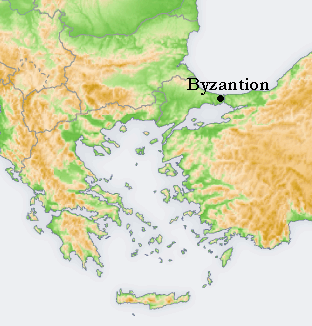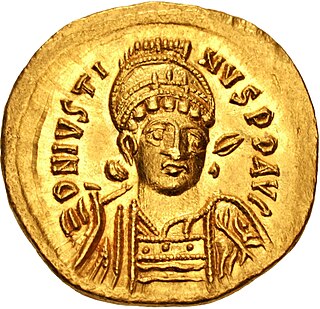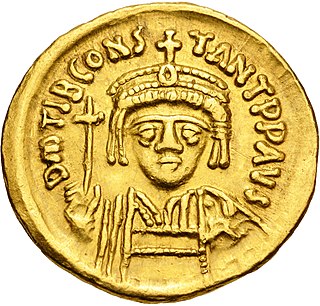
Byzantium or Byzantion was an ancient Greek city in classical antiquity that became known as Constantinople in late antiquity and Istanbul today. The Greek name Byzantion and its Latinization Byzantium continued to be used as a name of Constantinople sporadically and to varying degrees during the thousand-year existence of the Eastern Roman Empire, which was commonly referred to by the former name of that city, the Byzantine Empire. Byzantium was colonized by Greeks from Megara in the 7th century BC and remained primarily Greek-speaking until its conquest by the Ottoman Empire in AD 1453.

Justinian I, also known as Justinian the Great, was the Roman emperor from 527 to 565.

Leo III the Isaurian, also known as the Syrian or the Assyrian, was the first Byzantine emperor of the Isaurian dynasty from 717 until his death in 741. He put an end to the Twenty Years' Anarchy, a period of great instability in the Byzantine Empire between 695 and 717, marked by the rapid succession of several emperors to the throne, along with ending the continual defeats and territorial losses the Byzantines had suffered during the 7th century. He also successfully defended the Empire against the invading Umayyads and forbade the veneration of icons.

The labarum was a vexillum that displayed the "Chi-Rho" symbol ☧, a christogram formed from the first two Greek letters of the word "Christ" – Chi (χ) and Rho (ρ). It was first used by the Roman emperor Constantine the Great.

Anastasius I Dicorus was Eastern Roman emperor from 491 to 518. A career civil servant, he came to the throne at the age of 61 after being chosen by Ariadne, the wife of his predecessor, Zeno. His reign was characterized by reforms and improvements in the empire's government, finances, economy and bureaucracy. The resulting stable government, reinvigorated monetary economy and sizeable budget surplus allowed the empire to pursue more ambitious policies under his successors, most notably Justinian I. Since many of Anastasius' reforms proved long-lasting, his influence over the empire endured for centuries.

Artemius Anastasius, known as Anastasius II, was the Byzantine emperor from 713 to 715. His reign was marked by significant religious and political decisions aimed at stabilizing the Empire. One of his notable actions was reversing the previous appointment of a Monothelete patriarch of Constantinople, instead reinstating Orthodoxy by appointing Germanus I to the position. This move was made in an effort to gain the favor of Pope Constantine.
Zosimus was a Greek historian who lived in Constantinople during the reign of the eastern Roman Emperor Anastasius I (491–518). According to Photius, he was a comes, and held the office of "advocate" of the imperial treasury. Zosimus was also known for condemning Constantine’s rejection of the traditional polytheistic religion.

Justin I, also called Justin the Thracian, was Eastern Roman emperor from 518 to 527. Born to a peasant family, he rose through the ranks of the army to become commander of the imperial guard and when Emperor Anastasius I Dicorus died, he out-maneouvered his rivals and was elected as his successor, in spite of being around 68 years old. His reign is significant for the founding of the Justinian dynasty that included his eminent nephew, Justinian I, and three succeeding emperors. His consort was Empress Euphemia.

Tiberius II Constantine was Eastern Roman emperor from 574 to 582. Tiberius rose to power in 574 when Justin II, prior to a mental breakdown, proclaimed him caesar and adopted him as his own son. In 578, the dying Justin II gave him the title of augustus, thus becoming co-emperor alongside him. Tiberius became sole ruler less than two weeks later, assuming the regnal name of "Constantine" under which he reigned until his death.

Heraclius Constantine, often enumerated as Constantine III, was one of the shortest reigning Byzantine emperors, ruling for three months in 641. He was the eldest son of Emperor Heraclius and his first wife Eudokia.
Evagrius Scholasticus was a Syrian scholar and intellectual living in the 6th century AD, and an aide to the patriarch Gregory of Antioch. His surviving work, Ecclesiastical History, comprises a six-volume collection concerning the Church's history from the First Council of Ephesus (431) to the emperor Maurice’s reign until Scholasticus' death.
Byzantine currency, money used in the Eastern Roman Empire after the fall of the West, consisted of mainly two types of coins: gold solidi and hyperpyra and a variety of clearly valued bronze coins. By the 15th century, the currency was issued only in debased silver stavrata and minor copper coins with no gold issue. The Byzantine Empire established and operated several mints throughout its history. Aside from the main metropolitan mint in the capital, Constantinople, a varying number of provincial mints were also established in other urban centres, especially during the 6th century.
The Henotikon was a christological document issued by Byzantine emperor Zeno in 482, in an unsuccessful attempt to reconcile the differences between the supporters of the Council of Chalcedon and the council's opponents. It was followed by the Acacian schism.

The Edict of Milan was the February, AD 313 agreement to treat Christians benevolently within the Roman Empire. Western Roman Emperor Constantine I and Emperor Licinius, who controlled the Balkans, met in Mediolanum and, among other things, agreed to change policies towards Christians following the edict of toleration issued by Emperor Galerius two years earlier in Serdica. The Edict of Milan gave Christianity legal status and a reprieve from persecution but did not make it the state church of the Roman Empire, which occurred in AD 380 with the Edict of Thessalonica, when Nicene Christianity received normative status.

Basileus is a Greek term and title that has signified various types of monarchs throughout history. In the English-speaking world it is perhaps most widely understood to mean 'monarch', referring to either a 'king' or an 'emperor'. The title was used by sovereigns and other persons of authority in ancient Greece, the Byzantine emperors, and the kings of modern Greece. The name Basileios (Basil), deriving from the term basileus, is a common given name in the Eastern Orthodox Church and Eastern Catholic Churches.

The Byzantine economy was among the most robust economies in the Mediterranean for many centuries. Constantinople was a prime hub in a trading network that at various times extended across nearly all of Eurasia and North Africa. Some scholars argue that, up until the arrival of the Arabs in the 7th century, the Eastern Roman Empire had the most powerful economy in the world. The Arab conquests, however, would represent a substantial reversal of fortunes contributing to a period of decline and stagnation. Constantine V's reforms marked the beginning of a revival that continued until 1204. From the 10th century until the end of the 12th, the Byzantine Empire projected an image of luxury, and the travelers were impressed by the wealth accumulated in the capital. All this changed with the arrival of the Fourth Crusade, which was an economic catastrophe. The Palaiologoi tried to revive the economy, but the late Byzantine state would not gain full control of either the foreign or domestic economic forces.

The Anastasian War was fought from 502 to 506 between the Byzantine Empire and the Sasanian Empire. It was the first major conflict between the two powers since 440, and would be the prelude to a long series of destructive conflicts between the two empires over the next century.

The comes sacrarum largitionum was one of the senior fiscal officials of the late Roman Empire and the early Byzantine Empire.
Vitalian was a general of the Eastern Roman Empire. A native of Moesia in the northern Balkans, and probably of mixed Roman and Gothic or Scythian barbarian descent, he followed his father into the imperial army, and by 513 had become a senior commander in Thrace.

The Eastern Roman Empire was ruled by the House of Leo from AD 457, the accession of Leo I, to 518, the death of Anastasius I. The rule of the Leonid dynasty coincided with the rapid decline, collapse and eventual fall of the Western Roman Empire. Following the end of the Western Empire, Emperor Zeno abolished the position of Western Roman Emperor and declared himself the sole Roman Emperor. The Eastern Roman Empire would come to last for several more centuries, and subsequent dynasties would invest large amounts of resources in attempts to retake the western provinces.













